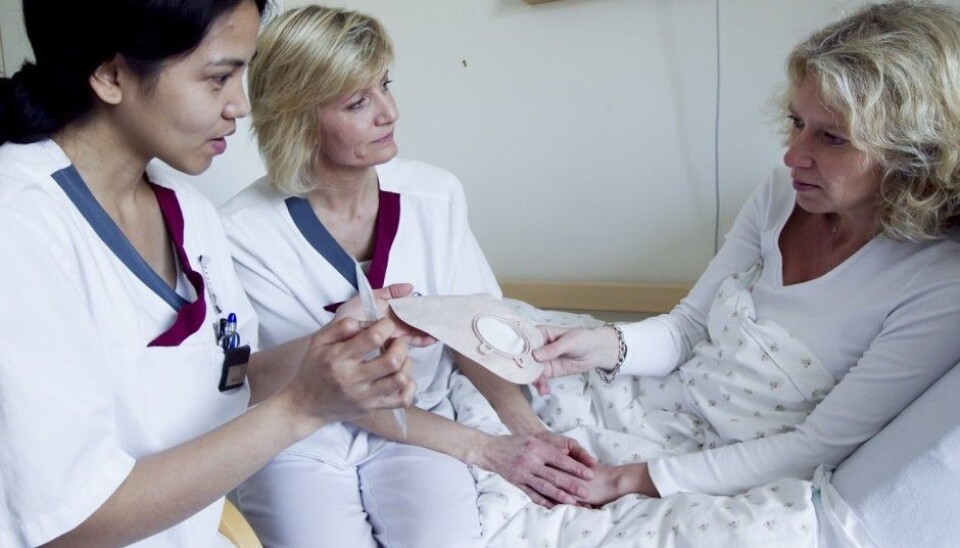An article from Norwegian SciTech News at SINTEF

The less educated are less satisfied with health services
Norwegians who have only completed primary school tend to be less satisfied with the national health service than their more highly educated compatriots, finds a recent study.
Denne artikkelen er over ti år gammel og kan inneholde utdatert informasjon.
What do people think about their encounters with their GP or specialist health care system? Health researchers Marian Ådnanes and Karin Dyrstad at Sintef carried out a survey of 2,700 people in Norway in collaboration with the Norwegian Heart and Lung Association (LHL).
The answers from the survey showed that the percentage of satisfied health care users increased with the length of their education.
“Our material says nothing about why this is the case, but one possible explanation is that it is really about communication. People with higher education may be better than others at filtering out relevant information from several sources, and thus at asking the right questions when they meet highly educated personnel, who tend to use technical jargon,” says Karin Dyrstad.
It may be that the educated group feel that they are on the same wavelength as health-care professionals, more than those with less education do."
Less educated people have more health problems
The survey also confirmed that overall, people with a lower level of education suffer from poorer health than the highly educated. This split does not simply run along the line of higher versus basic education.
Persons with a three-year degree or diploma are also more likely to have poor health, and to be less satisfied with the health service, than those who have been educated to master’s level.
Mental health patients less satisfied than cancer patients
Satisfaction with health care services also varies according to the type of disease or health problem respondents said that they suffered from.
Those who have or have had psychological or skeletomuscular problems are less satisfied than other groups of patients. Persons who have or have had cancer, cardiovascular disease, stroke or brain haemorrhage, on the other hand, tend to be more satisfied than the rest of the population.
"Nor here do the data offer any explanation for the differences observed. It may be that cancer is so highly prioritised in Norway that cancer patients simply are given a better set of treatment options than mentally ill patients, for example,” says Dyrstad.
Cancer at the top of people’s list of priorities
The survey revealed that there is little agreement concerning the criteria that determine who and what should be given priority in the health sector. However, cancer stands on its own and heads the list of diseases that we think should be prioritised.
Overall, the results suggest that many people feel that it is difficult to decide what should be given priority.
How people define quality in health services
The four most important criteria of good quality in the provision of health services, as the general public perceive them, are geographical proximity to hospitals and doctors, well-educated healthcare personnel, effective treatment and short waiting times.
Free choice of doctor and hospital do not appear until well down on the list of what people regard as important quality factors.
A large majority believe that the responsibility for the provision of health services ought to lie with the public sector.
In parallel to the questionnaire survey, SINTEF has used official statistics to create the following snapshot of Norwegians’ health:
- One of the most important causes of the increase in longevity among the Norwegian population since the 70s is the fall in mortality due to cardiovascular disease.
- There has also been a fall in cancer mortality rates in the course of the past few years.
- Chronic obstructive lung disease (COLD) has become one of the most common reasons for admission to Norwegian hospitals.
- Skeletomuscular problems are the most important cause of sick-leave, although the proportion of persons taking sick-leave for this reason is currently falling.
- The proportion of patients suffering from mental health problems rose from 10 to 18 percent between 1994 and 2010.
- The use of medications that act on the central nervous system has risen significantly. For example, there has been a large increase in medicines used to treat attention deficit hyperactivity disorder (ADHD). The number of users, mostly boys between the ages of 10 and 14, rose by 159 percent between 2004 and 2013, while the number of doses prescribed increased by no less than 225 percent, indicating a rise in consumption per person.
The use of antidepressants has risen by 21 percent (by number of doses) between 2004 and 2013. Since 2010, the increase has largely been among 15- to 19-year-old girls.
<link rel="canonical" href="http://gemini.no/en/2015/05/the-less-educated-are-less-satisfied-with-health-services/" />

































